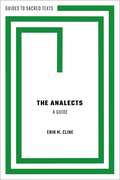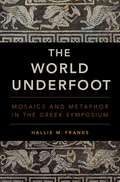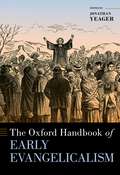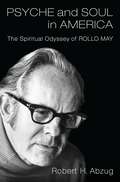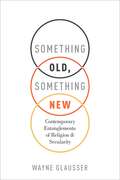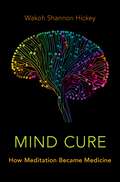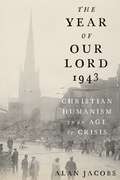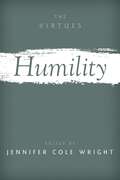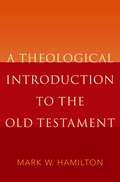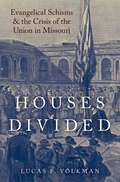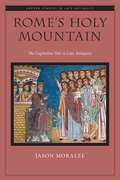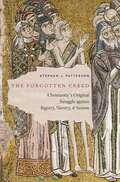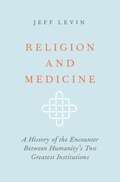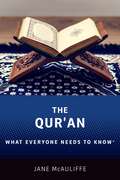- Table View
- List View
The Analects: A Guide (Guides to Sacred Texts)
by Erin M. ClineThe Analects (Lunyu) is the earliest and most influential record of the teachings of Kongzi (551-479 B.C.E.), known to most Westerners as "Confucius." If we measure influence according to the number of people who have lived their lives according to the teachings of a particular text, there is a good argument to be made that the Analects has been the most influential text in the world. This book argues that we have good reasons to study the Analects as a sacred text, and that doing so sheds light not only on the text and the Confucian tradition, but on what the sacred is, more broadly. It begins by examining what it means for a text to be regarded as sacred in relation to the unique history of this remarkably influential book, and goes on to offer a close study of the Analects, including its structure, its composition and compilation, and the purpose it has served in the Confucian tradition as the earliest and most authoritative record of Kongzi's teachings and conduct. The book further considers the history of the Analects as the most authoritative collection of Confucian teachings which virtually all major Confucians--as well as Chinese thinkers throughout history from the Mohist, Daoist, and Buddhist traditions--responded. This book explores the text, situating its teachings in relation to the religious practices of its time (including Zhou rituals and customs known as li and the veneration of ancestor and nature spirits), and discusses the Analects use and reception both in the periods following its composition and compilation and throughout China's imperial history up through the modern era, including the recent revival of activity in Confucian temples.
The World Underfoot: Mosaics and Metaphor in the Greek Symposium
by Hallie M. FranksIn the Greek Classical period, the symposium--the social gathering at which male citizens gathered to drink wine and engage in conversation--was held in a room called the andron. From couches set up around the perimeter, symposiasts looked inward to the room's center, which often was decorated with a pebble mosaic floor. These mosaics provided visual treats for the guests, presenting them with images of mythological scenes, exotic flora, dangerous beasts, hunting parties, or the spectre of Dionysos: the god of wine, riding in his chariot or on the back of a panther. In The World Underfoot, Hallie M. Franks takes as her subject these mosaics and the context of their viewing. Relying on discourses in the sociology and anthropology of space, she presents an innovative new interpretation of the mosaic imagery as an active contributor to the symposium as a metaphorical experience. Franks argues that the images on mosaic floors, combined with the ritualized circling of the wine cup and the physiological reaction to wine during the symposium, would have called to mind other images, spaces, or experiences, and in doing so, prompted drinkers to reimagine the symposium as another kind of event--a nautical voyage, a journey to a foreign land, the circling heavens or a choral dance, or the luxury of an abundant past. Such spatial metaphors helped to forge the intimate bonds of friendship that are the ideal result of the symposium and that make up the political and social fabric of the Greek polis.
The World Underfoot: Mosaics and Metaphor in the Greek Symposium
by Hallie M. FranksIn the Greek Classical period, the symposium--the social gathering at which male citizens gathered to drink wine and engage in conversation--was held in a room called the andron. From couches set up around the perimeter, symposiasts looked inward to the room's center, which often was decorated with a pebble mosaic floor. These mosaics provided visual treats for the guests, presenting them with images of mythological scenes, exotic flora, dangerous beasts, hunting parties, or the spectre of Dionysos: the god of wine, riding in his chariot or on the back of a panther. In The World Underfoot, Hallie M. Franks takes as her subject these mosaics and the context of their viewing. Relying on discourses in the sociology and anthropology of space, she presents an innovative new interpretation of the mosaic imagery as an active contributor to the symposium as a metaphorical experience. Franks argues that the images on mosaic floors, combined with the ritualized circling of the wine cup and the physiological reaction to wine during the symposium, would have called to mind other images, spaces, or experiences, and in doing so, prompted drinkers to reimagine the symposium as another kind of event--a nautical voyage, a journey to a foreign land, the circling heavens or a choral dance, or the luxury of an abundant past. Such spatial metaphors helped to forge the intimate bonds of friendship that are the ideal result of the symposium and that make up the political and social fabric of the Greek polis.
The Oxford Handbook of Early Evangelicalism (OXFORD HANDBOOKS SERIES)
by Edited by Jonathan YeagerEvangelicalism, a worldwide interdenominational movement within Protestant Christianity, is one of the most popular and diverse religious movements in the world today. Evangelicals maintain the belief that the essence of the Gospel consists of the doctrine of salvation by grace, through faith in Jesus' atonement. Evangelicals can be found on every continent and among nearly all Christian denominations. The origin of this group of people has been traced to the turn of the eighteenth century, with roots in the Puritan and Pietist movements in England and Germany. The earliest evangelicals could be found among Anglicans, Baptists, Congregationalists, Methodists, Moravians, and Presbyterians throughout North America, Britain, and Western Europe, and included some of the foremost names of the age, such as Jonathan Edwards, John Wesley, and George Whitefield. Early evangelicals were abolitionists, historians, hymn writers, missionaries, philanthropists, poets, preachers, and theologians. They participated in the major cultural and intellectual currents of the day, and founded institutions of higher education not limited to Dartmouth College, Brown University, and Princeton University. The Oxford Handbook of Early Evangelicalism provides the most authoritative and comprehensive overview of the significant figures and religious communities associated with early evangelicalism within the contextual and cultural environment of the long eighteenth century, with essays written by the world's leading experts in the field of eighteenth-century studies.
The Oxford Handbook of Early Evangelicalism (OXFORD HANDBOOKS SERIES)
by Edited by Jonathan YeagerEvangelicalism, a worldwide interdenominational movement within Protestant Christianity, is one of the most popular and diverse religious movements in the world today. Evangelicals maintain the belief that the essence of the Gospel consists of the doctrine of salvation by grace, through faith in Jesus' atonement. Evangelicals can be found on every continent and among nearly all Christian denominations. The origin of this group of people has been traced to the turn of the eighteenth century, with roots in the Puritan and Pietist movements in England and Germany. The earliest evangelicals could be found among Anglicans, Baptists, Congregationalists, Methodists, Moravians, and Presbyterians throughout North America, Britain, and Western Europe, and included some of the foremost names of the age, such as Jonathan Edwards, John Wesley, and George Whitefield. Early evangelicals were abolitionists, historians, hymn writers, missionaries, philanthropists, poets, preachers, and theologians. They participated in the major cultural and intellectual currents of the day, and founded institutions of higher education not limited to Dartmouth College, Brown University, and Princeton University. The Oxford Handbook of Early Evangelicalism provides the most authoritative and comprehensive overview of the significant figures and religious communities associated with early evangelicalism within the contextual and cultural environment of the long eighteenth century, with essays written by the world's leading experts in the field of eighteenth-century studies.
Psyche and Soul in America: The Spiritual Odyssey of Rollo May
by Robert H. AbzugIn post-World War II America and especially during the turbulent 1960s and 1970s, the psychologist Rollo May contributed profoundly to the popular and professional response to a widely felt sense of personal emptiness amid a culture in crisis. May addressed the sources of depression, powerlessness, and conformity but also mapped a path to restore authentic individuality, intimacy, creativity, and community. A psychotherapist by trade, he employed theology, philosophy, literature, and the arts to answer a central enduring question: "How, then, shall we live?" Robert Abzug's definitive biography traces May's epic life from humble origins in the Protestant heartland of the Midwest to his longtime practice in New York City and his participation in the therapeutic culture of California. May's books--Love and Will, Man's Search for Himself, The Courage to Create, and others--as well as his championing of non-medical therapeutic practice and introduction of Existential psychotherapy to America marked important contributions to the profession. Most of all, May's compelling prose reached millions of readers from all walks of life, finding their place, as Noah Adams noted in his NPR eulogy, "on a hippy's bookshelf." And May was one of the founders of the humanistic psychology movement that has shaped the very vocabulary with which many Americans describe their emotional and spiritual lives. Based on full and uncensored access to May's papers and original oral interviews, Psyche and Soul in America reveals his turbulent inner life, his religious crises, and their influence on his contribution to the world of psychotherapy and the culture beyond. It adds new and intimate dimensions to an important aspect of America's romance with therapy, as the site for the exploration of spiritual strivings and moral dilemmas unmet for many by traditional religion.
Psyche and Soul in America: The Spiritual Odyssey of Rollo May
by Robert H. AbzugIn post-World War II America and especially during the turbulent 1960s and 1970s, the psychologist Rollo May contributed profoundly to the popular and professional response to a widely felt sense of personal emptiness amid a culture in crisis. May addressed the sources of depression, powerlessness, and conformity but also mapped a path to restore authentic individuality, intimacy, creativity, and community. A psychotherapist by trade, he employed theology, philosophy, literature, and the arts to answer a central enduring question: "How, then, shall we live?" Robert Abzug's definitive biography traces May's epic life from humble origins in the Protestant heartland of the Midwest to his longtime practice in New York City and his participation in the therapeutic culture of California. May's books--Love and Will, Man's Search for Himself, The Courage to Create, and others--as well as his championing of non-medical therapeutic practice and introduction of Existential psychotherapy to America marked important contributions to the profession. Most of all, May's compelling prose reached millions of readers from all walks of life, finding their place, as Noah Adams noted in his NPR eulogy, "on a hippy's bookshelf." And May was one of the founders of the humanistic psychology movement that has shaped the very vocabulary with which many Americans describe their emotional and spiritual lives. Based on full and uncensored access to May's papers and original oral interviews, Psyche and Soul in America reveals his turbulent inner life, his religious crises, and their influence on his contribution to the world of psychotherapy and the culture beyond. It adds new and intimate dimensions to an important aspect of America's romance with therapy, as the site for the exploration of spiritual strivings and moral dilemmas unmet for many by traditional religion.
Something Old, Something New: Contemporary Entanglements of Religion and Secularity
by Wayne GlausserSomething Old, Something New: Contemporary Entanglements of Religion and Secularity offers a fresh perspective on debates surrounding religious and secular thinking. In each chapter, Wayne Glausser focuses on a topic of contemporary relevance in which something old (the sacrament of extreme unction, Greek rhetorical tropes, scholastic theology) entangles with something new (psilocybin therapy for the dying, the New Atheism, cognitive science). Glausser uses the term "entanglement" to describe his distinctive approach to the relationship between religion and secularity. The concept of entanglement refers to a contentious but oddly intimate relationship in which secular ideas compete with corresponding religious convictions, but neither side wins by displacing the other. As traditional religious knowledge and values come into conflict with their secular counterparts, the old ideas undergo stress and adaptation, but the influence works in both directions. Whether they do so consciously or unconsciously, entangled secularists engage with and sometimes borrow from older paradigms they believe they have surpassed. Something Old, Something New takes an unusual approach to this popular debate, and offers a new perspective in the conversation between believers and secularists. This is a book that theists, atheists, agnostics, and everyone still searching for the right label will find respectful but provocative.
Something Old, Something New: Contemporary Entanglements of Religion and Secularity
by Wayne GlausserSomething Old, Something New: Contemporary Entanglements of Religion and Secularity offers a fresh perspective on debates surrounding religious and secular thinking. In each chapter, Wayne Glausser focuses on a topic of contemporary relevance in which something old (the sacrament of extreme unction, Greek rhetorical tropes, scholastic theology) entangles with something new (psilocybin therapy for the dying, the New Atheism, cognitive science). Glausser uses the term "entanglement" to describe his distinctive approach to the relationship between religion and secularity. The concept of entanglement refers to a contentious but oddly intimate relationship in which secular ideas compete with corresponding religious convictions, but neither side wins by displacing the other. As traditional religious knowledge and values come into conflict with their secular counterparts, the old ideas undergo stress and adaptation, but the influence works in both directions. Whether they do so consciously or unconsciously, entangled secularists engage with and sometimes borrow from older paradigms they believe they have surpassed. Something Old, Something New takes an unusual approach to this popular debate, and offers a new perspective in the conversation between believers and secularists. This is a book that theists, atheists, agnostics, and everyone still searching for the right label will find respectful but provocative.
Mind Cure: How Meditation Became Medicine
by Wakoh Shannon HickeyMindfulness and yoga are widely said to improve mental and physical health, and booming industries have emerged to teach them as secular techniques. This movement is typically traced to the 1970s, but it actually began a century earlier. Wakoh Shannon Hickey shows that most of those who first advocated meditation for healing were women: leaders of the "Mind Cure" movement, which emerged during the late nineteenth and early twentieth centuries. Instructed by Buddhist and Hindu missionaries, many of these women believed that by transforming consciousness, they could also transform oppressive conditions in which they lived. For women - and many African-American men - "Mind Cure" meant not just happiness, but liberation in concrete political, economic, and legal terms. In response to the perceived threat posed by this movement, white male doctors and clergy with elite academic credentials began to channel key Mind Cure methods into "scientific" psychology and medicine. As mental therapeutics became medicalized and commodified, the religious roots of meditation, like the social-justice agendas of early Mind Curers, fell by the wayside. Although characterized as "universal," mindfulness has very specific historical and cultural roots, and is now largely marketed by and accessible to affluent white people. Hickey examines religious dimensions of the Mindfulness movement and clinical research about its effectiveness. By treating stress-related illness individualistically, she argues, the contemporary movement obscures the roles religious communities can play in fostering civil society and personal wellbeing, and diverts attention from systemic factors fueling stress-related illness, including racism, sexism, and poverty.
Mind Cure: How Meditation Became Medicine
by Wakoh Shannon HickeyMindfulness and yoga are widely said to improve mental and physical health, and booming industries have emerged to teach them as secular techniques. This movement is typically traced to the 1970s, but it actually began a century earlier. Wakoh Shannon Hickey shows that most of those who first advocated meditation for healing were women: leaders of the "Mind Cure" movement, which emerged during the late nineteenth and early twentieth centuries. Instructed by Buddhist and Hindu missionaries, many of these women believed that by transforming consciousness, they could also transform oppressive conditions in which they lived. For women - and many African-American men - "Mind Cure" meant not just happiness, but liberation in concrete political, economic, and legal terms. In response to the perceived threat posed by this movement, white male doctors and clergy with elite academic credentials began to channel key Mind Cure methods into "scientific" psychology and medicine. As mental therapeutics became medicalized and commodified, the religious roots of meditation, like the social-justice agendas of early Mind Curers, fell by the wayside. Although characterized as "universal," mindfulness has very specific historical and cultural roots, and is now largely marketed by and accessible to affluent white people. Hickey examines religious dimensions of the Mindfulness movement and clinical research about its effectiveness. By treating stress-related illness individualistically, she argues, the contemporary movement obscures the roles religious communities can play in fostering civil society and personal wellbeing, and diverts attention from systemic factors fueling stress-related illness, including racism, sexism, and poverty.
The Year of Our Lord 1943: Christian Humanism in an Age of Crisis
by Alan JacobsBy early 1943, it had become increasingly clear that the Allies would win the Second World War. Around the same time, it also became increasingly clear to many Christian intellectuals on both sides of the Atlantic that the soon-to-be-victorious nations were not culturally or morally prepared for their success. A war won by technological superiority merely laid the groundwork for a post-war society governed by technocrats. These Christian intellectuals-Jacques Maritain, T. S. Eliot, C. S. Lewis, W. H. Auden, and Simone Weil, among others-sought both to articulate a sober and reflective critique of their own culture and to outline a plan for the moral and spiritual regeneration of their countries in the post-war world. In this book, Alan Jacobs explores the poems, novels, essays, reviews, and lectures of these five central figures, in which they presented, with great imaginative energy and force, pictures of the very different paths now set before the Western democracies. Working mostly separately and in ignorance of one another's ideas, the five developed a strikingly consistent argument that the only means by which democratic societies could be prepared for their world-wide economic and political dominance was through a renewal of education that was grounded in a Christian understanding of the power and limitations of human beings. The Year of Our Lord 1943 is the first book to weave together the ideas of these five intellectuals and shows why, in a time of unprecedented total war, they all thought it vital to restore Christianity to a leading role in the renewal of the Western democracies.
The Year of Our Lord 1943: Christian Humanism in an Age of Crisis
by Alan JacobsBy early 1943, it had become increasingly clear that the Allies would win the Second World War. Around the same time, it also became increasingly clear to many Christian intellectuals on both sides of the Atlantic that the soon-to-be-victorious nations were not culturally or morally prepared for their success. A war won by technological superiority merely laid the groundwork for a post-war society governed by technocrats. These Christian intellectuals-Jacques Maritain, T. S. Eliot, C. S. Lewis, W. H. Auden, and Simone Weil, among others-sought both to articulate a sober and reflective critique of their own culture and to outline a plan for the moral and spiritual regeneration of their countries in the post-war world. In this book, Alan Jacobs explores the poems, novels, essays, reviews, and lectures of these five central figures, in which they presented, with great imaginative energy and force, pictures of the very different paths now set before the Western democracies. Working mostly separately and in ignorance of one another's ideas, the five developed a strikingly consistent argument that the only means by which democratic societies could be prepared for their world-wide economic and political dominance was through a renewal of education that was grounded in a Christian understanding of the power and limitations of human beings. The Year of Our Lord 1943 is the first book to weave together the ideas of these five intellectuals and shows why, in a time of unprecedented total war, they all thought it vital to restore Christianity to a leading role in the renewal of the Western democracies.
Humility (The Virtues)
The 21st century has seen a renewed interest in cultivating positive character traits, or virtues, to foster personal growth. Humility is a virtue that has long been understood--especially by early theological thinking and Western philosophers--through its associations with meekness and servility. Even in more recent, secular contexts, humility is associated with low-mindedness, self-denigration, and even self-loathing. While it seems paradoxical that this virtue can be developed to achieve a sense of well-being, this volume provides a comprehensive exploration of humility as an admirable and desirable trait that allows us to place the needs of others before our own, keep our accomplishments in perspective, and fully realize our small place in the world. In a series of multidisciplinary essays spanning religious and secular traditions, this volume introduces readers to the many facets of humility. Essays explore perspectives from Christianity, Judaism, and Islam on the role of humility in determining how we should align ourselves with a higher spiritual power. Other essays examine the epistemic value of humility in the development of knowledge, and the applied nature of this virtue within the professional fields of politics, business management, nursing and hospice care, and competitive sports. This collection concludes by considering the possibility of humility as the most important virtue, foundational to the moral development and expression of all other virtues.
HUMILITY BVS C (The Virtues)
by Jennifer Cole WrightThe 21st century has seen a renewed interest in cultivating positive character traits, or virtues, to foster personal growth. Humility is a virtue that has long been understood--especially by early theological thinking and Western philosophers--through its associations with meekness and servility. Even in more recent, secular contexts, humility is associated with low-mindedness, self-denigration, and even self-loathing. While it seems paradoxical that this virtue can be developed to achieve a sense of well-being, this volume provides a comprehensive exploration of humility as an admirable and desirable trait that allows us to place the needs of others before our own, keep our accomplishments in perspective, and fully realize our small place in the world. In a series of multidisciplinary essays spanning religious and secular traditions, this volume introduces readers to the many facets of humility. Essays explore perspectives from Christianity, Judaism, and Islam on the role of humility in determining how we should align ourselves with a higher spiritual power. Other essays examine the epistemic value of humility in the development of knowledge, and the applied nature of this virtue within the professional fields of politics, business management, nursing and hospice care, and competitive sports. This collection concludes by considering the possibility of humility as the most important virtue, foundational to the moral development and expression of all other virtues.
A Theological Introduction to the Old Testament
by Mark W. HamiltonThe book known as the Old Testament is actually a collection of stories, songs, prophetic addresses, wise sayings, and other bits of literature composed over centuries and compiled for the use of worshiping communities. These texts appeared in ancient Israel, reflecting its traumas and less frequent triumphs. Far from being comfortable texts that sedate over-stimulated readers, they offer critique of the powerful for the sake of those for whom the only tool of overcoming oppression is language itself. Because of the distance in time and cultural experience, the Old Testament is often inaccessible to modern readers. This introduction bridges that distance and makes the connections across time and culture come alive. The Bible assembles a wide range of literary types because of the needs of the communities first using it as they preserved the legacy of their past, good and bad, for the sake of a viable future. Their legacy continues as relevant as ever. This introduction, then, seeks to help readers make sense of the variety and hear within it points of commonality as well. The Old Testament is a book readers look to for meaning. Christian readers, especially, have difficulty connecting with the theological meanings of the texts. Mark Hamilton offers an introduction that addresses theological issues directly and sensitively. Considering the massive sweep of literary types and ways of expressing ideas about God, A Theological Introduction to the Old Testament offers an alternative to introductions based solely on historical or literary themes.
Houses Divided: Evangelical Schisms and the Crisis of the Union in Missouri (Religion in America)
by Lucas VolkmanHouses Divided provides new insights into the significance of the nineteenth-century evangelical schisms that arose initially over the moral question of African American bondage. Volkman examines such fractures in the Baptist, Methodist, and Presbyterian churches of the slaveholding border state of Missouri. He maintains that congregational and local denominational ruptures before, during, and after the Civil War were central to the crisis of the Union in that state from 1837 to 1876. The schisms were interlinked religious, legal, constitutional, and political developments rife with implications for the transformation of evangelicalism and the United States from the late 1830s to the end of Reconstruction. The evangelical disruptions in Missouri were grounded in divergent moral and political understandings of slavery, abolitionism, secession, and disloyalty. Publicly articulated by factional litigation over church property and a combative evangelical print culture, the schisms were complicated by the race, class, and gender dynamics that marked the contending interests of white middle-class women and men, rural church-goers, and African American congregants. These ruptures forged antagonistic northern and southern evangelical worldviews that increased antebellum sectarian strife and violence, energized the notorious guerilla conflict that gripped Missouri through the Civil War, and fueled post-war vigilantism between opponents and proponents of emancipation. The schisms produced the interrelated religious, legal and constitutional controversies that shaped pro-and anti-slavery evangelical contention before 1861, wartime Radical rule, and the rise and fall of Reconstruction.
Rome's Holy Mountain: The Capitoline Hill in Late Antiquity (Oxford Studies in Late Antiquity)
by Jason MoraleeRome's Capitoline Hill was the smallest of the Seven Hills of Rome. Yet in the long history of the Roman state it was the empire's holy mountain. The hill was the setting of many of Rome's most beloved stories, involving Aeneas, Romulus, Tarpeia, and Manlius. It also held significant monuments, including the Temple of Jupiter Optimus Maximus, a location that marked the spot where Jupiter made the hill his earthly home in the age before humanity. This is the first book that follows the history of the Capitoline Hill into late antiquity and the early middle ages, asking what happened to a holy mountain as the empire that deemed it thus became a Christian republic. This is not a history of the hill's tonnage of marble and gold bedecked monuments, but rather an investigation into how the hill was used, imagined, and known from the third to the seventh centuries CE. During this time, the imperial triumph and other processions to the top of the hill were no longer enacted. But the hill persisted as a densely populated urban zone and continued to supply a bridge to fragmented memories of an increasingly remote past through its toponyms. This book is also about a series of Christian engagements with the Capitoline Hill's different registers of memory, the transmission and dissection of anecdotes, and the invention of alternate understandings of the hill's role in Roman history. What lingered long after the state's disintegration in the fifth century were the hill's associations with the raw power of Rome's empire.
The Forgotten Creed: Christianity's Original Struggle against Bigotry, Slavery, and Sexism
by Stephen J. PattersonLong before the followers of Jesus declared him to be the Son of God, Jesus taught his followers that they too were the children of God. This ancient creed, now all but forgotten, is recorded still within the folds of a letter of Paul the Apostle. Paul did not create this creed, nor did he fully embrace it, but he quoted it and thus preserved it for a time when it might become important once again. This ancient creed said nothing about God or Christ or salvation. Its claims were about the whole human race: there is no race, there is no class, there is no gender. This is the story of that first, forgotten creed, and the world of its begetting, a world in which foreigners were feared, slaves were human chattel, and men questioned whether women were really human after all. Into this world the followers of Jesus proclaimed: "You are all children of God. There is no Jew or Greek, no slave or free, no male and female, for you are all one." Where did this remarkable statement of human solidarity come from, and what, finally, happened to it? How did Christianity become a Gentile religion that despised Jews, condoned slavery as the will of God, and championed patriarchy? Christian theologians would one day argue about the nature of Christ, the being of God, and the mechanics of salvation. But before this, in the days when Jesus was still fresh in the memory of those who knew him, the argument was a different one: how can human beings overcome the ways by which we divide ourselves one from another? Is solidarity possible beyond race, class, and gender?
The Forgotten Creed: Christianity's Original Struggle against Bigotry, Slavery, and Sexism
by Stephen J. PattersonLong before the followers of Jesus declared him to be the Son of God, Jesus taught his followers that they too were the children of God. This ancient creed, now all but forgotten, is recorded still within the folds of a letter of Paul the Apostle. Paul did not create this creed, nor did he fully embrace it, but he quoted it and thus preserved it for a time when it might become important once again. This ancient creed said nothing about God or Christ or salvation. Its claims were about the whole human race: there is no race, there is no class, there is no gender. This is the story of that first, forgotten creed, and the world of its begetting, a world in which foreigners were feared, slaves were human chattel, and men questioned whether women were really human after all. Into this world the followers of Jesus proclaimed: "You are all children of God. There is no Jew or Greek, no slave or free, no male and female, for you are all one." Where did this remarkable statement of human solidarity come from, and what, finally, happened to it? How did Christianity become a Gentile religion that despised Jews, condoned slavery as the will of God, and championed patriarchy? Christian theologians would one day argue about the nature of Christ, the being of God, and the mechanics of salvation. But before this, in the days when Jesus was still fresh in the memory of those who knew him, the argument was a different one: how can human beings overcome the ways by which we divide ourselves one from another? Is solidarity possible beyond race, class, and gender?
The Reformation of Prophecy: Early Modern Interpretations of the Prophet & Old Testament Prophecy (Oxford Studies in Historical Theology)
by G. Sujin PakProtestant reformers found the prophet and biblical prophecy to be exceptionally effective for framing their reforming work under the authority of Scripture-for the true prophet speaks the Word of God alone and calls the people, their worship, and their beliefs and practices back to the Word of God. uses the prophet and biblical prophecy as a powerful lens through which to view many aspects of the reformers in the sixteenth and seventeenth centuries. G. Sujin Pak argues that these prophetic concepts served the substantial purposes of articulating a theology of the priesthood of all believers, a biblical model of the pastoral office, a biblical vision of the reform of worship, and biblical processes for discerning right interpretation of Scripture. Pak demonstrates the ways in which understandings of the prophet and biblical prophecy contributed to the formation of distinct confessional identities. She goes on to demonstrate the waning of explicit prophetic terminology, particularly among the next generation of Protestant leadership. Eventually, she shows, the Protestant reformers concluded that the figure of the prophet carried with it as many problems as it did benefits, though they continued to give much time and attention to the exegesis of biblical prophetic writings.
The Reformation of Prophecy: Early Modern Interpretations of the Prophet & Old Testament Prophecy (Oxford Studies in Historical Theology)
by G. Sujin PakProtestant reformers found the prophet and biblical prophecy to be exceptionally effective for framing their reforming work under the authority of Scripture-for the true prophet speaks the Word of God alone and calls the people, their worship, and their beliefs and practices back to the Word of God. uses the prophet and biblical prophecy as a powerful lens through which to view many aspects of the reformers in the sixteenth and seventeenth centuries. G. Sujin Pak argues that these prophetic concepts served the substantial purposes of articulating a theology of the priesthood of all believers, a biblical model of the pastoral office, a biblical vision of the reform of worship, and biblical processes for discerning right interpretation of Scripture. Pak demonstrates the ways in which understandings of the prophet and biblical prophecy contributed to the formation of distinct confessional identities. She goes on to demonstrate the waning of explicit prophetic terminology, particularly among the next generation of Protestant leadership. Eventually, she shows, the Protestant reformers concluded that the figure of the prophet carried with it as many problems as it did benefits, though they continued to give much time and attention to the exegesis of biblical prophetic writings.
Religion and Medicine: A History of the Encounter Between Humanity's Two Greatest Institutions
by Jeff LevinThough the current political climate might lead one to suspect that religion and medicine make for uncomfortable bedfellows, the two institutions have a long history of alliance. From religious healers and religious hospitals to religiously informed bioethics and research studies on the impact of religious and spiritual beliefs on physical and mental well-being, religion and medicine have encountered one another from antiquity through the present day. In Religion and Medicine, Dr. Jeff Levin outlines this longstanding history and the multifaceted interconnections between these two institutions. The first book to cover the full breadth of this subject, it documents religion-medicine alliances across religious traditions, throughout the world, and over the course of history. Levin summarizes a wide range of material in the most comprehensive introduction to this emerging field of scholarship to date.
Religion and Medicine: A History of the Encounter Between Humanity's Two Greatest Institutions
by Jeff LevinThough the current political climate might lead one to suspect that religion and medicine make for uncomfortable bedfellows, the two institutions have a long history of alliance. From religious healers and religious hospitals to religiously informed bioethics and research studies on the impact of religious and spiritual beliefs on physical and mental well-being, religion and medicine have encountered one another from antiquity through the present day. In Religion and Medicine, Dr. Jeff Levin outlines this longstanding history and the multifaceted interconnections between these two institutions. The first book to cover the full breadth of this subject, it documents religion-medicine alliances across religious traditions, throughout the world, and over the course of history. Levin summarizes a wide range of material in the most comprehensive introduction to this emerging field of scholarship to date.
The Qur'an: What Everyone Needs to Know® (What Everyone Needs to Know)
by Jane McAuliffeMillions of non-Muslims know the name of the Muslim scripture, whether it is written as "Qur'an" or "Quran" or "Koran." But for most, that is all they know. Many have fallen victim to the mass of misinformation that circulates about the Qur'an. Others may have tried to read the Qur'an, but the text itself is tough to decipher. With no sense of context, chronology, or interpretive history, many would-be readers of the Qur'an quickly give up the effort. As for those trying to find out what the Qur'an says about any particular subject or issue, they, too, soon discover that this is not a simple or straightforward undertaking. A clear, concise introduction to the holy book that guides the lives of 1.6 billion people on our planet, this brief volume opens the world of the Qur'an to interested readers who want to know where this scripture came from and how it has achieved a profound influence in today's world. Writing in an easy-to-read question-and-answer format, Jane McAuliffe, one of the world's foremost scholars of the Qur'an, introduces readers to this important text by discussing its origins, structure, themes, interpretations, and what it has to say about a host of critical contemporary issues. Where did the Qur'an come from? Do Muslims believe that the Qur'an is God's own word? How do Muslims study the Qur'an? What does the Qur'an say about God? About family? About ethics? About violence? By answering the questions that many people have about the Qur'an and its role in Muslim faith, this book offers an invaluable resource for anyone who is curious about one of the world's most important faiths.
